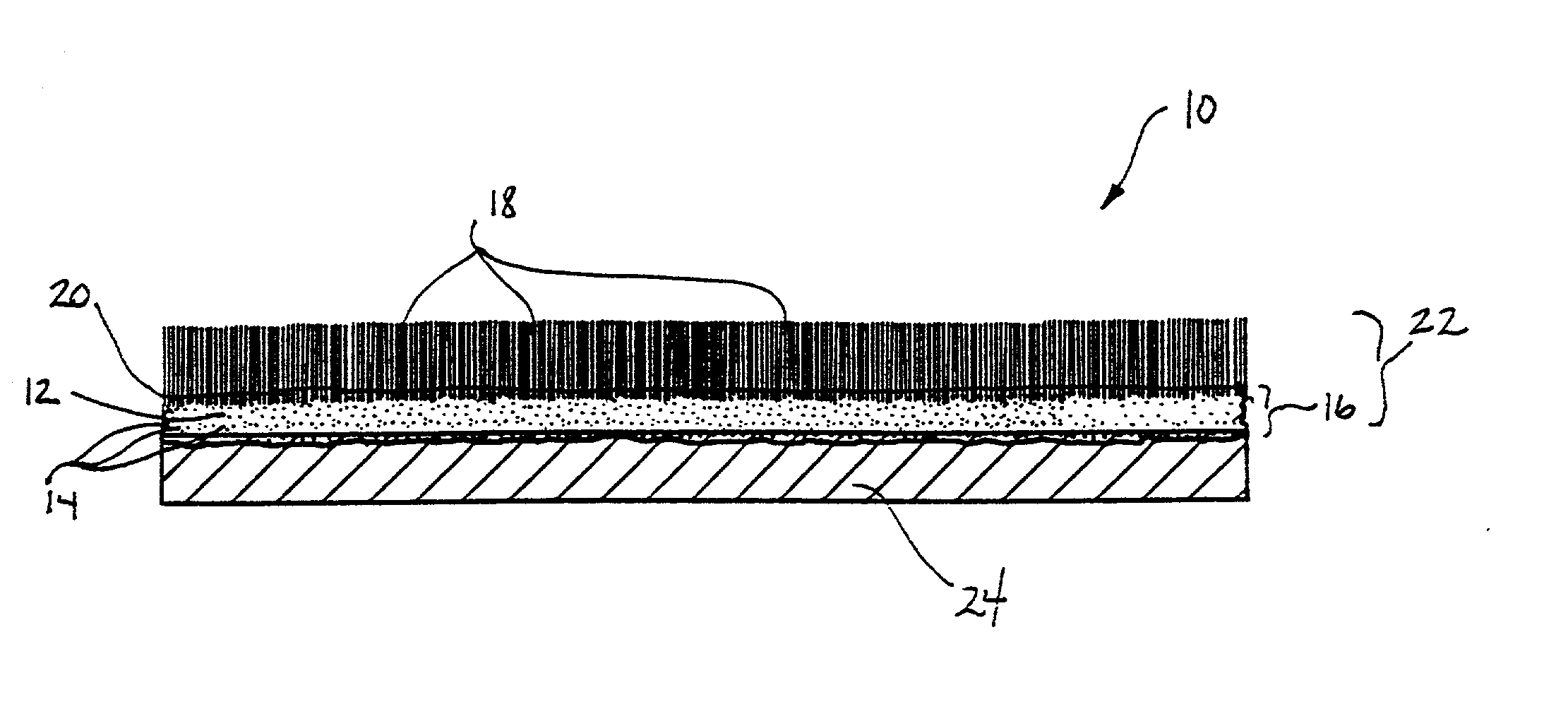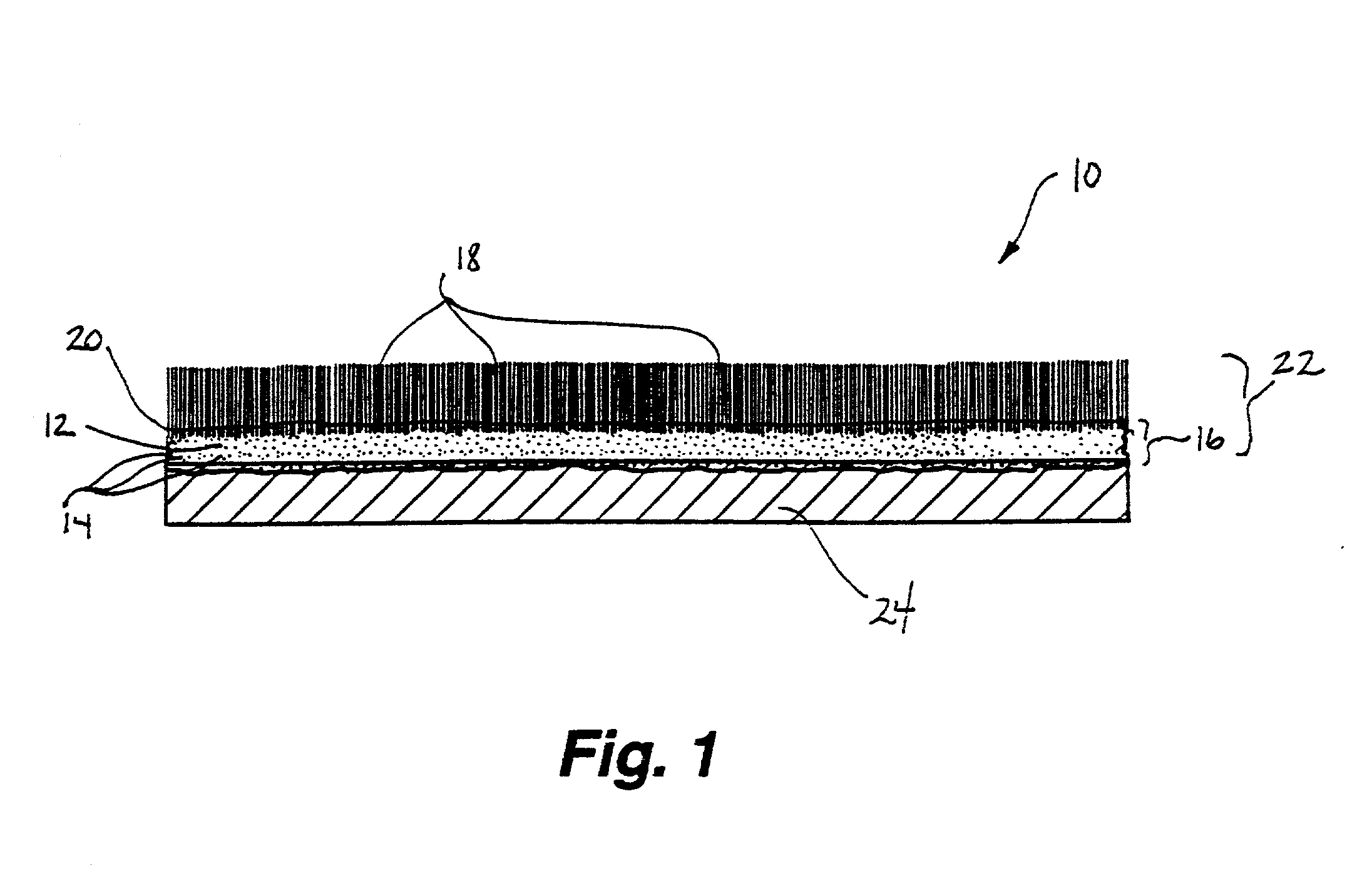Fabric coating containing energy absorbing phase change material and method of manufacturing same
a phase change material and fabric coating technology, applied in the field of fabric coatings, can solve the problems of unsatisfactory use of phase change material microspheres in thermoplastic gravure printing techniques, inability to achieve uniform dispersion of microspheres in the binder, and inability to apply phase change material binder binder to commercial coating equipmen
- Summary
- Abstract
- Description
- Claims
- Application Information
AI Technical Summary
Benefits of technology
Problems solved by technology
Method used
Image
Examples
example ii
[0047] An alternative coating formulation where high phase change material content and limited extensibility is required, for example with non- or low-stretch fabrics such as non-woven or woven fabrics, is prepared as shown in Table III.
3TABLE III COMPONENT WT % DIRECTIONS Hycar XT9202 21.00 75% DOS 0.40 Strodex PK90 (90% NV) 0.33 Mix. 50% wet n-Octadecane 72.00 Add slowly to latex polymer microspheres mixture, with good mixing, dispersing microspheres well. Acrysol ASE60 (28% NV) 4.40 AF9020 (20% NV) 0.05 Hercules Advantage 831 0.30 Mix ingredients slowly until foam dissipates. Ammonium Hydroxide (28%) 1.52 Add slowly, with good mixing.
[0048] Addition of microspheres as described above in the preferred weight ratios eliminates tack and prevents blocking of the coated fabrics typically experienced with coatings having low glass transition temperature polymers such as those based on acrylic latex polymers. Tack, the tendency of material to stick to itself, can make rolls of coated fa...
example iii
[0050] A preferred foam coating formulation of the present invention may be used with breathable fabric to maintain the heat and moisture dissipation capability of the fabric. In this example, the materials are subject to mechanical frothing. Foam stabilizers are added to maintain the foam after application to the fabric. Foam stabilizers may be inorganic salts of fatty acids or their sulfate partial esters, anionic surfactants, among other compounds. Preferred foam stabilizers for use with phase change material microspheres are sodium lauryl sulfate, ammonium stearate, di-sodium-n-octadecyl sulfosuccinamate and mixtures thereof. Ammonium stearate concentrations (dry as a percent of wet coating) of 0.5% to 6% plus 0.2% to 4% sulfosuccinamate are most preferred. The coatings are prepared as shown in Table IV.
4TABLE IV COMPONENT WT % DIRECTIONS Water 4.69 75% DOS 0.20 Strodex PK90 (90% NV) 0.17 Hycar XT9202 33.74 35% wet n-Octadecane 54.53 Add slowly to above ingredients, microspheres...
example iv
[0054] Tests were conducted on acrylic fleeces in which the fibers containing microPCMs, and on non-woven materials (sometimes referred to herein as "substrate") having a coating containing microPCMs. Acrylic fleeces without microPCMs having approximately the same weight per unit area as the fleeces with microPCMs, and substrates without microPCMs having the same thickness as the non-woven substrates having a coating containing microPCMs, served as comparison materials. Specific data regarding the sample materials tested are included in Table V.
5TABLE V Acrylic Substrate Acrylic without Substrate without Materials Tested with PCM PCM with PCM PCM Wt / unit area (g / m.sup.2) 270 250 227 207 Stand thickness (mm) 5.40 5.63 0.63 0.61 Compressibility 12 16 13 20 (lbs) Raw density (kg / m.sup.3) 49 44 360 339
[0055] The content of microPCM in the acrylic fleeces was approximately 10 per cent. About 7 g / m.sup.2 microPCM was included in the coating of the non-woven substrate. This is equal to a c...
PUM
| Property | Measurement | Unit |
|---|---|---|
| temperature | aaaaa | aaaaa |
| elongation at break | aaaaa | aaaaa |
| glass transition temperature | aaaaa | aaaaa |
Abstract
Description
Claims
Application Information
 Login to View More
Login to View More - R&D
- Intellectual Property
- Life Sciences
- Materials
- Tech Scout
- Unparalleled Data Quality
- Higher Quality Content
- 60% Fewer Hallucinations
Browse by: Latest US Patents, China's latest patents, Technical Efficacy Thesaurus, Application Domain, Technology Topic, Popular Technical Reports.
© 2025 PatSnap. All rights reserved.Legal|Privacy policy|Modern Slavery Act Transparency Statement|Sitemap|About US| Contact US: help@patsnap.com


